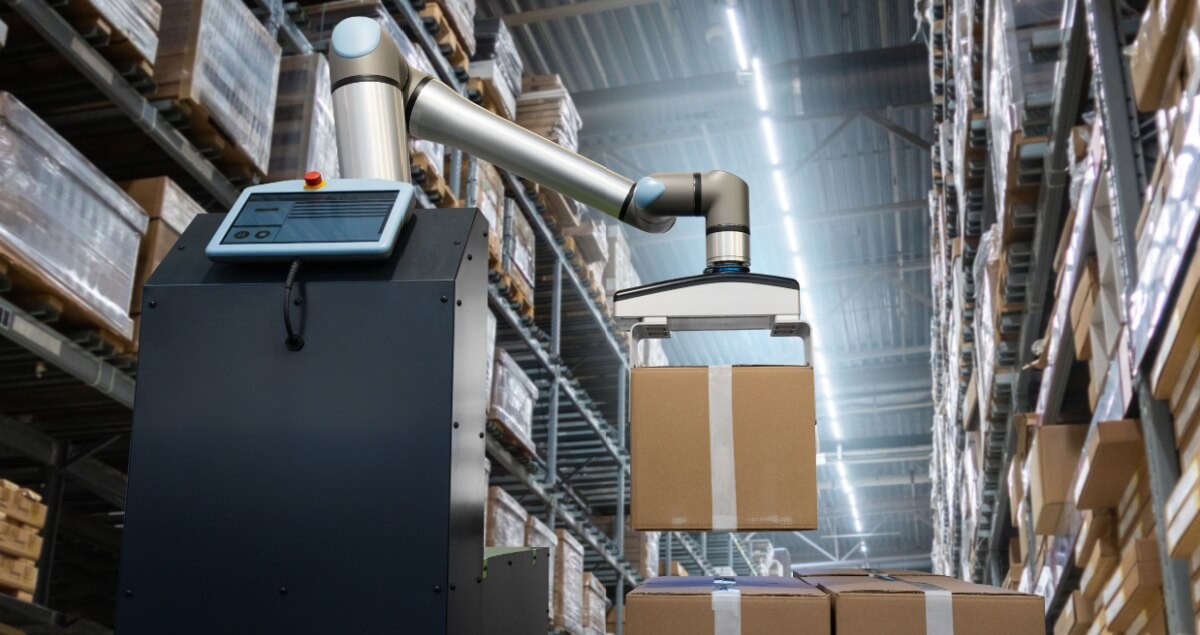Key Takeaways:
- The supply chain’s technological revolution is driven in part by the adoption of warehouse robotics, which efficiently perform tasks traditionally done manually.
- Examples of warehouse robotics include autonomous mobile robots, robotic picking arms, and automated storage and retrieval systems.
- Robotic systems have a widespread impact in areas that include packing and picking, inventory management, and even last-mile delivery.
- Integration with durable iGPS plastic pallets further enhances the efficiency of robotic warehouse systems.
How Warehouse Robotics Are Changing the Supply Chain
The supply chain as we know it is undergoing a technological revolution, and at the forefront of this transformation is modern warehouse robotics. Automation for enterprises of every size has become a necessity as enterprises endeavor to improve efficiency, address resource shortages, and reduce their Total Cost of Business. Robotics within warehouses and fulfillment centers is reshaping how goods are received, stored, and shipped. From robotic arms and autonomous mobile robots to AI-driven sorting systems, these innovations are part of a rapidly growing industry that is making facilities smarter and more adaptable as businesses seek to optimize their logistic operations and address rising consumer demand.
What Is Warehouse Robotics?
Warehouse robotics refers to the use of fully automated systems, including autonomous vehicles and AI-driven robotic arms, to perform tasks that are traditionally managed by human workers doing manual labor. These robots are able to transport inventory, support order fulfillment, and perform other work that streamlines the logistics process.
New advancements in artificial intelligence and machine learning have made warehouse robotics more efficient and adaptable than ever before, with robots now working alongside human employees, reducing labor-intensive tasks while improving productivity across the board.
3 Examples of Warehouse Robotics
There are various types of robotic systems, each designed to fulfill specific functions within a warehouse or other logistics facility. These include:
Autonomous Mobile Robots (AMRs)
- AMRs use sensor technology and artificial intelligence systems to navigate warehouses independently, without being controlled by human operators.
- Unlike traditional automated guided vehicles (AGVs), which move along fixed paths, AMRs can continually adapt to their surroundings, avoiding obstacles and optimizing their routes in real time.
- Companies such as Amazon use AMRs to move inventory between storage locations and order fulfillment areas.
Robotic Picking Arms
- These nimble, automated arms use AI and sophisticated vision technology to identify, pick, and place products accurately.
- Robotic arm systems are often integrated with conveyor systems to help automate sorting and packing.
- E-commerce and retail businesses employ robotic picking arms to hasten order fulfillment while also reducing the possibility of human error.
Automated Storage and Retrieval Systems (AS/RS)
- An AS/RS consists of a computer-controlled system that automatically stores and retrieves items from within designated warehouse locations.
- These systems increase vertical storage density, minimize retrieval times, and reduce the need for manual labor while also improving safety. They can also scan RFID chips embedded within pallets to ensure that products are placed in the appropriate storage lanes.
- Industries with high-volume inventory turnover, such as grocery distribution and pharmaceuticals, rely on AS/RS technology for seamless inventory management.
Impact of Robots on Supply Chain Efficiency
Warehouse robotics systems dramatically optimize supply chain efficiency by automating typically labor-intensive processes, reducing potential errors, and enhancing overall speed. Here are just a few of the ways in which advanced robotic systems are reshaping important segments of warehouse operations:
Automated Picking and Packing
Picking and packing are among the most time-consuming tasks within a warehouse environment. Robots equipped with AI-driven vision systems can quickly identify and pick products, reducing fulfillment times. Automated packing machines, meanwhile, can further improve efficiency by making sure that each order is properly packaged for shipment, reducing packaging waste while minimizing the possibility of shipping errors.
Improved Inventory Management
Warehouse robotics can help streamline inventory tracking by scanning barcodes, RFID tags, and QR codes with unparalleled precision. Automated inventory systems prevent stock discrepancies, reduce overstocking and stockouts, and enable real-time transparency of inventory status. Through the provision of timely and accurate data, robotics help supply chain managers make informed decisions about demand forecasting and inventory replenishment.
Enhanced Sorting and Distribution
Sorting and distribution are important facets of supply chain efficiency, especially within complex e-commerce and retail operations. Automated sorting systems use conveyor belts, AI-powered “electronic eyes,” and agile robotic arms to categorize and route products to the correct shipping lanes swiftly and efficiently. This speeds up order processing while ensuring accuracy.
Optimized Last-Mile Delivery
Even outside the confines of the warehouse, robotic technologies are also contributing to last-mile delivery optimization. Companies are presently testing autonomous robots and drones for last-mile package delivery, which can reduce reliance on human couriers. Additionally, robotic systems improve the efficiency of warehouse-to-truck loading processes, ensuring quicker turnaround times for outbound shipments.
Streamlined Production and Assembly
In industries that include automotive and electronics, highly advanced robots assemble products with unmatched precision, while collaborative robots, or cobots, work alongside human employees, handling repetitive assembly tasks and enabling human workers to focus on more complex operations and problem-solving. This integration enhances productivity and product quality while also cutting down on assembly times.
How Warehouse Robotics Integrate with Plastic Pallets
Plastic pallets, such as those available from iGPS Logistics, are a core component of modern warehouse logistics. Their uniform construction and seamless compatibility with robotics enhance automation processes. In contrast to traditional wood-block pallets, plastic pallets offer numerous advantages that make them ideal for robotic integration:
- Uniform Dimensions: Plastic pallets have precise and consistent dimensions and do not expand when exposed to moisture, ensuring smooth handling by robotic arms, conveyors, and automated guided vehicles (AGVs). This, along with the absence of protruding nails and splinters, reduces the risk of misalignment and mechanical failures.
- Durability and Longevity: Unlike wood pallets, which can splinter or break, plastic pallets are highly durable, withstanding repeated robotic handling without deterioration. In fact, an iGPS pallet typically lasts about four times as long as a wood pallet (actual, not lab-tested). This longevity improves environmental sustainability and reduces operational costs.
- Lightweight Yet Strong: Plastic pallets provide an ideal balance of strength and weight, allowing robots to transport heavy loads efficiently while minimizing energy consumption as well as equipment wear and tear.
- Hygienic and Easy to Clean: In industries such as food and beverage as well as pharmaceuticals, plastic pallets exceed strict hygiene standards. Their smooth, non-porous surfaces do not absorb moisture or harbor bacterial growth, making them easy to sanitize.
- RFID Compatibility: iGPS plastic pallets are embedded with RFID chips that enable swift counting and integration with automated storage and retrieval systems. This enhances both visibility and automation in supply chain operations.
By integrating lightweight, durable iGPS plastic pallets with warehouse robotics, enterprises can further improve efficiency, accuracy, and safety across the continuum of their logistics operations.
Warehouse robotics are fundamentally reshaping supply chain operations, enabling companies to automate vital processes, improve inventory accuracy, and enhance their overall efficiency across the board. From innovative autonomous mobile robots and robotic picking arms to advanced sorting systems, these technologies are central to the next generation of logistics management.
The integration of warehouse robotics with lightweight iGPS plastic pallets further optimizes supply chain automation. The durability, uniformity, and automation-friendly design of plastic pallets make them ideal for integration with robotic systems, enhancing warehouse efficiency while reducing costs.
Frequently Asked Questions
How do robots increase efficiency?
Robots increase efficiency by automating repetitive tasks with high precision and speed, significantly reducing human error and labor costs. Their seamless integration into production lines streamlines workflows, enabling continuous operation around the clock. This transformation in industrial processes not only accelerates production rates but also frees human workers to focus on innovative and strategic problem-solving initiatives, thus yielding substantial benefits.
How does AI affect supply chain performance?
AI enhances supply chain performance by providing advanced analytics, real-time insights, and predictive capabilities that optimize inventory management and logistics. Its algorithms detect inefficiencies and forecast demand, enabling rapid adjustments and informed decision-making. This technological advancement reduces operational costs and delivery delays while improving transparency across networks, ultimately fostering a more resilient, responsive, and competitive supply chain ecosystem with impact.
Businesses that recognize the efficiency advantages of warehouse robotics choose durable iGPS plastic pallets for their shipping needs. iGPS pallets are automation-friendly, and they save fuel and transportation costs. For more information, contact us at 1-800-884-0225, email a specialist at switch@igps.net, or visit our contact page.



